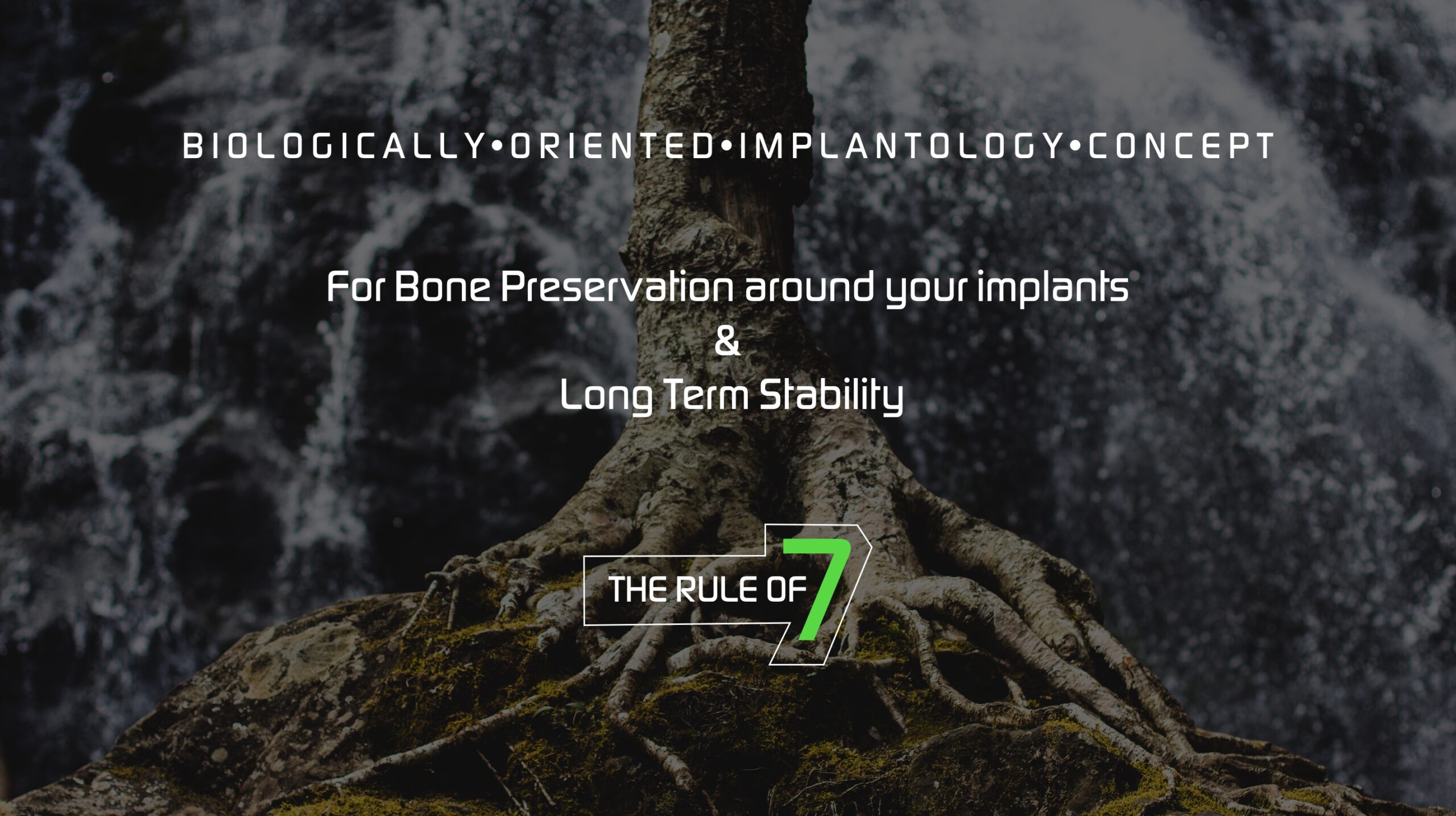The modern implantology has brought many breakthroughs and specially today digital work flow represents the most interesting topic but the truth is that Biology never changes and the biological rules represent the potential good or bad prognosis of our work as long as we respect those rules.
The Biology does not understand about digital work flow but the digital work flow can improve the relationship between the biology and our work since it connects in a very efficient manner all the elements to reduce time and costs as long as it sets Technology and Biology at the same level.
Biological principles are still the same as before we discovered the digital workflow. This is why the bone support integrity over our implants and peri implant health will be so important as well as the integrity of all the elements of the fixture, connections representing the base of our pyramid of success.
There are many variables that will condition the initial prognosis and final prognosis of our treatment this is the reason why we must establish certain biological rules of protection and bone preservation over our implants as well as to understand that the macro and micro design will be a key factor to achieve the main goal.
The Rule of 7 for bone preservation over our implants are summarized here but always applied in all the Masterclasses and Courses given in Dental Surgery Channel.
1-. Patient selection according to Systemic factors and Habits:
-Systemic factors: Many systemic diseases will condition our initial and final results of our work.
Diabetes M, Hypercholesterolemia, Vit D deficiency and many others will represent a risk when detected before the initial surgery so take that as a handicap when trying to make miracles happen. Sometimes by reducing the number of surgeries, applying minimally invasive techniques and not demanding so much to a body that is not set to respond properly will make the difference in our results.
The history of failures will set the initial map for you to take seriously the case before planning any surgery.
-Patient Habits: Excessive washing technique or deficient cleaning of the area will also represent a risk and potential wound dehiscence when follow up visits are attended.
This is a key factor as well when communicating with your patients. Mandatory good habits and mandatory indications to the patient may save or ruin your day. So explain clearly the post-op recommendations to avoid early complications by not telling the patient what she or he can and cannot do.
Bad self-habits such as smoking will need to be eliminated during not only the surgical phase but also the prosthetic until the work is completed, assuming a very low smoking habit as possible coexistence with our implants as long as the quantity is very low.
Gum chewing represent a very high risk of dehiscence since orbicular muscles are in constant movement and new reattachment insertions in a higher level will collapse your work.
These are some of the habits that live with the patient in a daily basis and we must be aware of their existence to protect our work against them.
2-. Surgical & Prosthetic Treatment planning according to the topographic knowledge of the area to treat:
It is very important to have knowledge of the anatomy in order to be aware of the surgical limitations in terms of management of the tissues but also the defect analysis to predict the potential regeneration will be mandatory according to the scenario, area to treat, amount of bone atrophy to assign a specific surgical technique to achieve predictable results by using different biomaterials conditioned by their biology.
The other important decisions are the ones made for immediate implant or delayed implant placement depending on the situation. This is why bone atrophy classification will guide us with specific decision making process into the most predictable way to work on the case.
3-. Biomaterial Selection:
The different sources and biomaterial process development make these strong or weak elements different from one another. It does not exist one for everything even if the company says so. Especially when comparing different atrophy scenarios mild moderate and severe.
Different biomaterials in the market respond to different necessities and each one of them have a different regenerative potential depending on many different factors.
This is the reason that understanding their biology is a MUST in order to predict their behavior and expect different results even when the appropriate biomaterial was used.
Limitations, different shape and morphology, combinations between them represent all the possibilities that should be used under a very high level of knowledge before trying formulas that have not been proven by scientific literature even when the companies promote them with no enough scientific support.
4-. Soft Tissue assessment: (Watch Master in Soft Tissue management and grafting in Dental Surgery Channel)
The quality & quantity of the soft tissues are essential for long term good prognosis since the good quality of our soft tissues around our implants will make a safe seal less prone to inflammation when there is a bacterial presence.
A good width of keratinized gingiva will resist the advancement and also will reduce the chances for gingival recession around teeth and implants.
Soft tissue grafting and management knowledge is mandatory if we want to provide our rehabilitation with a safe and protected environment.
5-. Implant System and level position of our implant regards bone crest:
The level position of our implant in relation with the alveolar crest will be determined by different factors mentioned here.
One is the macro design of our implant and the other one is the type of connection.
This is the reason why many implants with bone level concepts when submerged subcrestally they lose bone until the platform of the implant.
This wrong position when the system is not designed for that purpose will worsen the situation and will even promote the marginal bone loss creating vey deep pockets around our implants and mucositis and many other diseases will start to appear.
Sub-crestal Implant Systems design the fixtures and connections perfectly matched to promote the bone apposition over the implants to change the pattern of bone loss assumed until now, the 21st century.
Sub-crestal position is not a trend, is not a modification of our protocol if our implant system is not designed for that purpose.
What is clear is that by promoting bone apposition over our implant platforms and next to our connections changes the soft tissue growth pattern in contact with our implants avoiding soft tissue ingrowth searching for the platform and gap (critical area) as long as 7 Rules for Bone Preservation are respected.
6-. Specific osteotomy:
-The previous osteotomy prior to implant placement represents a wound over the bone, which responds remodeling starting by removing by a high osteoclastic activity the most intimate bone in contact with our implants.
This remodeling process will be encouraged by many factors and will be more aggressive if we compromise the vascularity of the bone.
Different ways to avoid to compromise the vascularity is by using low r.p.m when drilling osteotomy is performed.
In D1-D2: 100 – 200 r.p.m with copious irrigation will reduce the chances for overheating the area which is one factor that will encourage the excessive remodeling process.
In D3-D4: 50 r.p.m are enough and even with highly vascularized bone irrigation is not even needed.
The other factor is the bone compression at the crestal level when using tapered implant systems (90% of the practitioners) that needs a reduced diameter osteotomy to create that squeezed feeling at crestal bone to provide primary stability.
By using the same diameter implant at the most crestal aspect as the drilling osteotomy, we do not compress the bone at this critical area and promote the bone stability and no remodeling process is requested by the biology since a blood clot will establish and new bone formation will fill the gap over our implant.
The implant is provided by other elements to ensure primary stability such as progressive horizontal threads that will engage the implant into the bone and provide horizontal stability against non axial forces avoiding fibrointegration as well.
7-. Implant Abutment Connection:
Conical connections Morse Taper or Cone Morse between 5 and 11 degrees ensure self locking effect at the most critical area of our system which is the implant-abutment join.
By using conical connections compared to internal hex or even platform switching connections we avoid micro-movement of our connection against para-functional movements and micro leakage both reasons for peri implantitis development.
By using reduced connections at the implant platform level we allow bone apposition since we do not occupy the space.
*Bonus:
The quick osseointegrative implant surfaces have improved and raised the level of implant survival rate, which does not mean Implant Success rate.
What we assume is that by using quick osseointegrative implant surfaces we reduce the time for bone remodeling exposing the implant to a shorter threat time.
By loading our implants either immediately or in an early stage we are promoting the stability ahead of time and assuming bone mechanical stimulation when physiological loading forces are applied that will improve and reinforce all the biological and different elements that make our system unique and predictable.


